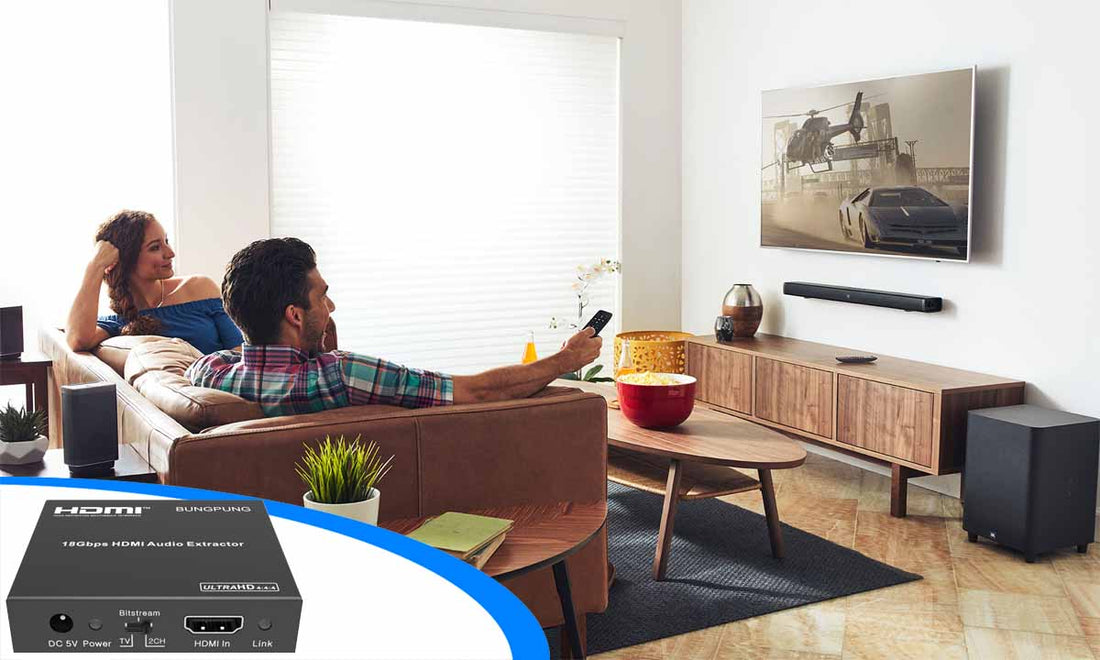
The Ultimate Guide to HDMI Audio Extractors: Unlocking the Power of Audio Flexibility
Share
In the world of audiovisual setups, HDMI audio extractors have emerged as powerful tools that provide flexibility and enhance the audio experience. Whether you're a home theater enthusiast or a professional in need of seamless audio integration, understanding the capabilities and benefits of HDMI audio extractors is essential. In this ultimate guide, we'll explore everything you need to know about HDMI audio extractors and how they can transform your audio setup.
What is an HDMI Audio Extractor and how does it works?
An HDMI audio extractor is a device designed to extract and separate audio signals from HDMI sources, allowing users to connect them to external audio systems or speakers. It serves as a bridge between HDMI source devices, such as Blu-ray players, PCs, or game consoles, and audio systems, amplifiers, or soundbars.
Functionality:
The primary function of an HDMI audio extractor is to extract audio signals from HDMI sources while passing through the video signal to the connected display device. By doing so, it enables users to have greater flexibility in managing their audio setup and customizing their audio experience according to their preferences.
How it Works:
HDMI audio extractors utilize advanced audio processing technology to separate and extract audio signals from the HDMI input. They typically have HDMI input ports to receive the audio and video signals and offer multiple audio output options for connecting to external audio systems. Common output options include analog audio (RCA), digital audio (optical or coaxial), or a 3.5mm audio jack.
The device decodes the audio signal from the HDMI input, processes it accordingly, and sends it to the selected audio output. Simultaneously, it passes the video signal through to the connected display device without any loss in quality.
Common Applications:
HDMI audio extractors find numerous applications across various scenarios where audio flexibility and integration are paramount. Here are some common examples:
- Home Theaters: In home theater setups, an HDMI audio extractor allows users to connect their HDMI sources, such as Blu-ray players or streaming devices, to external surround sound systems or audio receivers. This enables them to enjoy immersive audio experiences while maintaining high-quality video output on their displays.
- Conference Rooms: HDMI audio extractors are valuable in conference room setups where users need to connect their HDMI-enabled devices, such as laptops or video conferencing systems, to audio systems or speakers. This ensures clear and enhanced audio during presentations, video conferences, or meetings.
- Gaming Setups: Gamers often use HDMI audio extractors to connect their gaming consoles or PCs to external audio systems, soundbars, or gaming headsets. This enhances the gaming experience by providing immersive audio effects, spatial sound, and improved dialogue clarity.
- Educational Institutions: HDMI audio extractors are beneficial in educational settings, such as classrooms or lecture halls, where instructors need to connect their HDMI devices to audio systems for better audio projection. This ensures that students can hear the audio clearly, even in large or acoustically challenging spaces.
By extracting audio signals from HDMI sources, HDMI audio extractors offer unparalleled flexibility and enable users to tailor their audio setups to their specific needs. Whether it's enjoying cinematic sound at home, delivering impactful presentations, immersing in gaming experiences, or enhancing audio projection in educational environments, HDMI audio extractors play a crucial role in expanding audio possibilities.
Key Features and Benefits of HDMI Audio Extractors:
- Enhanced Audio Flexibility:
HDMI audio extractors offer enhanced audio flexibility by allowing users to extract audio separately from HDMI sources. This means you can route the audio signal to external audio systems or speakers while can keep the audio and video signal is sent to the display device. This feature enables customization of audio setups according to specific preferences and requirements.
- Compatibility:
HDMI audio extractors are designed to be highly compatible with a wide range of HDMI devices and audio systems. They can seamlessly integrate with devices such as televisions, monitors, projectors, gaming consoles, Blu-ray players, laptops, and more. Additionally, they can connect to various audio systems, including amplifiers, AV receivers, soundbars, or even headphones, making them versatile for different setups.
- Audio Formats and Output Options:
HDMI audio extractors support various audio formats and offer multiple output options, ensuring compatibility with different audio systems and setups. They can handle popular audio formats such as stereo, Dolby Digital, DTS, and even advanced formats like Dolby TrueHD and DTS-HD Master Audio. Output options typically include analog audio (RCA), digital audio (optical or coaxial), or a 3.5mm audio jack, allowing users to connect to the desired audio devices or systems.
- Signal Quality and Performance:
Maintaining high-quality audio is crucial when using HDMI audio extractors. These devices are designed to ensure reliable audio extraction without loss or degradation of the audio signal. They employ advanced signal processing technology to deliver clear, accurate, and immersive audio experiences. This means you can enjoy your favorite movies, music, or games with the utmost audio fidelity, preserving the original quality of the audio source.
In summary, HDMI audio extractors provide enhanced audio flexibility, compatibility with a wide range of devices, support for various audio formats, and deliver high-quality audio performance. These key features and benefits make HDMI audio extractors indispensable tools for those seeking to optimize their audio setups, whether it's for home theaters, gaming, presentations, or other audio-intensive applications.
How to Choosing the Right HDMI Audio Extractor?
When selecting an HDMI audio extractor, it's essential to consider several factors to ensure you choose the right device for your audio setup. Here are some key factors to keep in mind:
- Supported Audio Formats:
Check whether the HDMI audio extractor supports the audio formats you require. This includes formats such as stereo, Dolby Digital, DTS, Dolby TrueHD, and DTS-HD Master Audio. Ensure that the device can handle the specific audio formats that you intend to use in your setup. For maximum flexibility, some HDMI audio extractor also supports bitstream audio downmix to analog stereo output and keeps optical and HDMI out audio passthrough. Surround sound formats can be extracted from your HDMI source device and sent to your soundbar or AV receiver via the SPDIF port, while also simultaneously being downmixed into a stereo analog signal for your headphones via RCA. with the built-in Dolby Digital/DTS Decoder, you can gets the true audio experience they deserve.
- Input/Output Options:
Consider the input and output options provided by the HDMI audio extractor. Ensure it has the necessary input ports to connect your HDMI sources, such as televisions, gaming consoles, or Blu-ray players. Additionally, check for the output options that match your audio devices or systems, such as analog audio (RCA), digital audio (optical or coaxial), or a 3.5mm audio jack.
- Build Quality and Reliability:
Pay attention to the build quality and overall reliability of the HDMI audio extractor. Look for devices constructed with high-quality materials and durable components to ensure longevity. Reading product descriptions and customer reviews can provide insights into the reliability and sturdiness of the device.
- Reputable Brands and Models:
Consider opting for HDMI audio extractors from reputable brands known for their reliability and performance in the audio industry. Research and explore popular brands that have a track record of delivering quality audio products. Some well-known brands include XYZ Audio, BUNGPUNG Electronics, and PQR Sound Systems. Look for models with positive reviews and high ratings to ensure customer satisfaction.
- User Reviews and Ratings:
User reviews and ratings play a significant role in making an informed purchase decision. Check customer reviews on reliable e-commerce platforms or audio-focused websites to gather insights into the performance, reliability, and overall user experience of the HDMI audio extractor you are considering. Consider both positive and negative reviews to get a well-rounded understanding of the product's pros and cons.
By considering these factors and researching reputable brands and models, along with reading user reviews and ratings, you can make an informed decision when selecting the right HDMI audio extractor for your specific audio needs. This ensures that you invest in a reliable and high-performance device that will enhance your audio setup and provide a satisfying audio experience.
How to Setting Up and Optimizing Your HDMI Audio Extractor?
Setting up and optimizing your HDMI audio extractor is essential to ensure proper functionality and maximize audio performance. Follow these steps and tips for a smooth setup process:
- Connection and Configuration:
- Begin by identifying the HDMI input and output ports on the HDMI audio extractor and your HDMI source and display devices.
- Connect one end of an HDMI cable to the HDMI output port of your source device (e.g., Blu-ray player) and the other end to the HDMI input port of the HDMI audio extractor.
- Connect an additional HDMI cable from the HDMI output port of the HDMI audio extractor to the HDMI input port of your display device (e.g., TV or monitor).
- If your HDMI audio extractor has multiple audio output options (e.g., RCA or 3.5 mm L/R analog audio , SPDIF optical digital audio), connect the desired audio cables to your external audio system or speakers.
- Some devices are also equipped with an audio EDID setting switch, which allows users to select the audio format output supported by the display EDID, digital audio output or analog audio output.
- Power on all the connected devices, including the HDMI audio extractor.
- Troubleshooting Tips:
- If you encounter no audio or poor audio quality, ensure that all connections are secure and cables are undamaged.
- Check that the HDMI cables you're using are high-quality and capable of transmitting audio signals.
- Verify that your source device's audio settings are configured correctly, such as selecting the appropriate audio output format.
- If the audio is out of sync with the video, check if your HDMI audio extractor has any delay or lip-sync adjustment settings and make adjustments accordingly.
- If you experience signal dropouts or intermittent audio, try using shorter HDMI cables or consider using high-speed HDMI cables with better shielding.
- Optimizing Audio Settings:
- Access the audio settings on your source device (e.g., Blu-ray player, gaming console) and ensure the audio output is set to HDMI or the appropriate output option.
- Explore the audio settings on the HDMI audio extractor itself, if available. Adjust settings such as audio format, sample rate, or audio channel configuration to match your audio system's capabilities.
- If your HDMI audio extractor supports advanced audio features like Dolby Atmos or DTS:X, ensure that your audio system is compatible and configured to take advantage of these formats.
- Consider calibrating and fine-tuning your audio system by using audio test tones, calibration discs, or software tools to achieve optimal audio performance.
By following these steps, addressing common setup issues, and optimizing audio settings, you can ensure a seamless and optimized experience with your HDMI audio extractor. Remember to consult the user manual provided with your specific device for any manufacturer-specific instructions or additional setup considerations.
Conclusion:
With the rapid evolution of audiovisual technology, HDMI audio extractors have become indispensable tools for audio enthusiasts and professionals. By extracting audio signals from HDMI sources, these devices offer unprecedented flexibility, compatibility, and enhanced audio performance. Armed with the knowledge gained from this ultimate guide, you're now ready to embark on your audio journey and unlock the full potential of HDMI audio extractors.
Remember, when selecting an HDMI audio extractor, consider your specific needs and preferences, and don't forget to check user reviews to ensure you choose the right device for your setup. With the right HDMI audio extractor by your side, you can elevate your audio experience to new heights.
